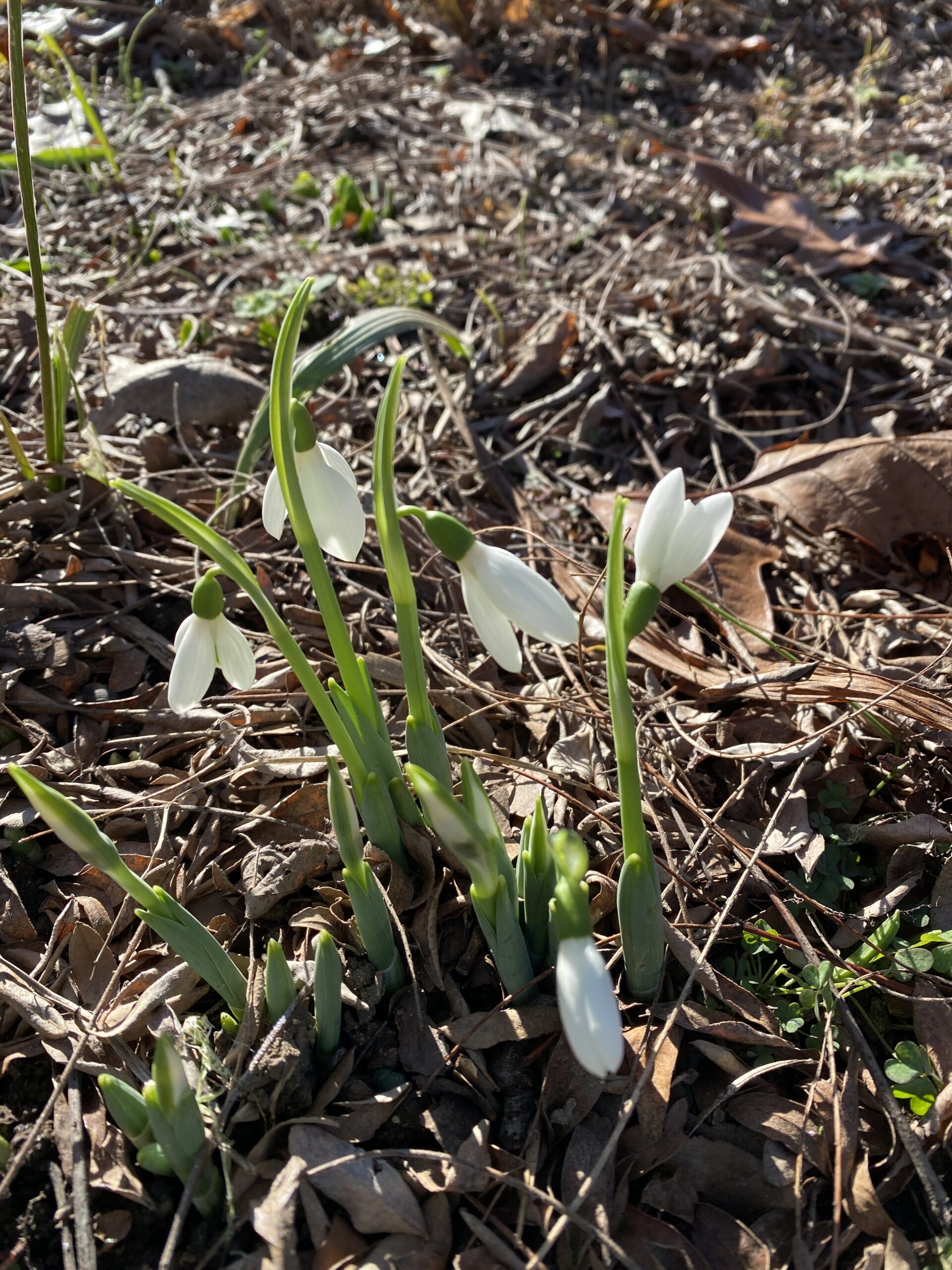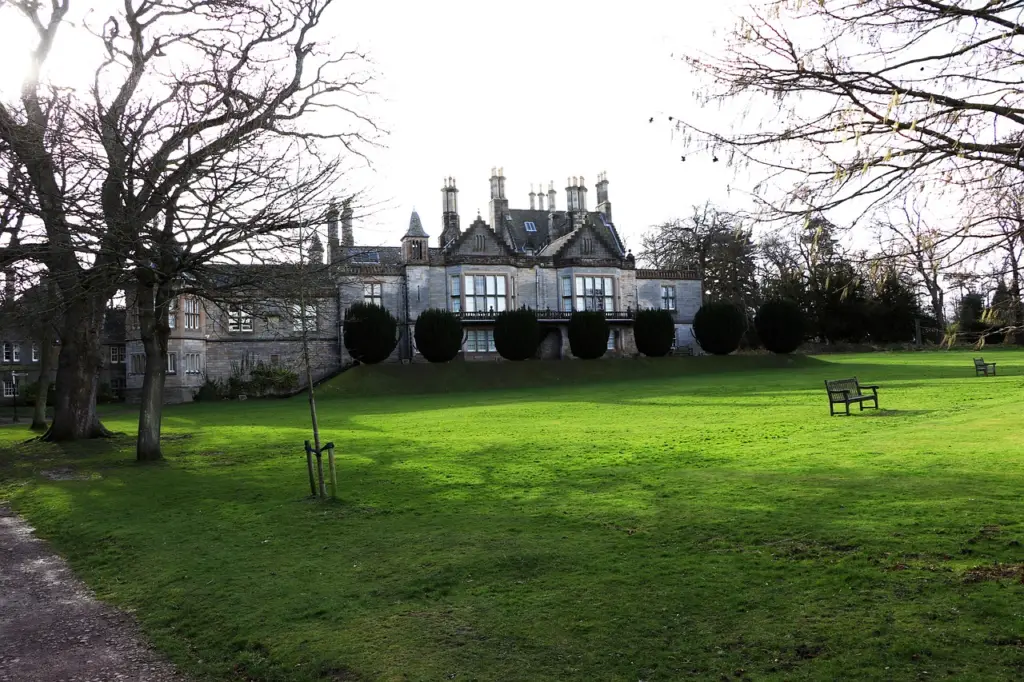[ad_1]
Subsequent up in my college lawn-class opinions: what I found about clover and completely different grass seed mixes that embody flowering vegetation, and what I might do if I (nonetheless) had a backyard myself.
Alternate choices to straightforward cool-season grasses
In climates the place cool-season grasses are grown, tall fescue and Kentucky bluegrass are the default, largely because of they’re solely form of backyard that will stand as much as heavy web site guests, along with sports activities actions. Nevertheless the place foot web site guests is light, there is also greater strategies to have a lawn-like expanse.
Clover
This main slide illustrates the evolution of attitudes about clover, as dictated by Scotts and completely different entrepreneurs of grass seed. For years, clover was intentionally added to grass seed mixes because of it “fixes” nitrogen from the ambiance (because of it’s a legume), subsequently decreasing the need for fertilizer. So clover was good?
Correctly, until 2,4-D was formulated and marketed because the latest new weedkiller for lawns, with a small downside – it moreover killed clover.
So to advertise the stuff, distributors wanted to shortly demonize clover as a nasty, disagreeable weed that wished to be killed! And in just a few years, public opinion had dutifully modified, to the advantage of Scotts notably.
Nevertheless at present, there’s renewed curiosity in clover – largely for its benefits to bees – and as quickly as as soon as extra it’s being included in (some) backyard seed mixes and marketed as producing a “greener backyard with a lot much less repairs.”
Proper right here’s turfgrass specialist Dr. Mark Carroll on the benefits of clover which could be driving its intentional re-introduction into lawns:
- Reduces need for nitrogen.
- Meals provide for pollinators

- Attracts wildlife. (This one I question – what completely different fascinating wildlife does it attraction to along with pollinators? Rabbits and deer LOVE the stuff!)
- Clover moreover “promotes coloration retention and turf density, nevertheless every outcomes shall be transitory.”
There are drawbacks to clover:
- It dies when subjected to every extreme temps and drought stress. And when it does, it releases large portions of nitrogen.

- It defoliates in winter, leaving bare soil that will set off sediment run-off. The clover will come once more lastly in May.
- A future downside is that clover spreads to neighboring yards. And after blowing into neighboring yards, microclovers grow to be full-size clovers.
- Even microclover is simply too aggressive to be combined with top quality fescues. (Nevertheless microclover CAN be combined with tall fescue and Kentucky bluegrass.)
- In surveys, many respondents don’t identical to the taller look of regular clover added to grasses, nevertheless microclover produces a additional uniform look and is far much less objectionable.

I personally seen clover’s means to out-compete completely different groundcovers as soon as I creatively (I believed) combined it with Sedum sarmentosum to cowl my 1,000 sf once more yard. It appeared so good at first that Top quality Gardening Journal requested me to jot down about this wonderful discovery! Sadly, by the purpose that article was printed, the clover had killed nearly the entire Sedum. On this {photograph} it’s successfully on its method, illustrating how its bigger high gave it the profit it wished to dominate.
Oops! I moved shortly thereafter, leaving the problem for the customers to deal with.
Top quality Fescue Lawns
Another choice is to change tall fescue or Kentucky bluegrass with lower-input, slower rising top quality fescues.
The advantages: As confirmed by a School of Maryland analysis, top quality fescues (laborious and sheep fescues) cut back mowing, fertilizing, irrigation and pests, which is why the faculty is “pushing it” as an alternative to normal turfgrasses. No irrigation is required and it requires mowing merely 1-2 situations per yr – in late fall and a second mowing in late June. That is, IF, primarily based on Dr. Carroll, “if you happen to occur to don’t ideas the look of tall grass, which appears completely completely different, with seedheads, identical to the robust areas of golf packages.”
Drawbacks of top quality fescue lawns embody that they aren’t aggressive ample to compete with clover and completely different flowers which may be added for biodiversity, and like clover, they don’t stand as a lot as sports activities actions or completely different heavy web site guests.
“Eco-lawns” (mixes of grasses and flowering vegetation)
The class found that “eco-lawn” is an concept from the Nineteen Eighties, when it attracted consideration as a choice to cut back the need for water or fertilizer, nevertheless is now attracting curiosity as a consequence of benefits to pollinators. “Entomologists have taken it and run with it.” Additional evaluation is being accomplished on these promising mixes, notably with legumes, and nonetheless additional is required.
The advantages embody these for prime quality fescues – drought tolerance, a lot much less need for fertilizer – plus help for pollinating bugs.

Drawbacks embody:
- The varied expenses of progress of the vegetation throughout the mix complicate the timing of mowing. Nevertheless in Dr. Carroll’s private Maryland eco-lawn he’s found a variety of flowers that survive frequent mowing heights: clover, violet, yarrow and speedwell. Speaking of mowing, backyard mowers can generally now be raised to 4 inches.
- Poor chopping tolerance.
- Excessive nitrogen loading by returned clippings.
- Broadleaf vegetation in mixes out-compete completely different vegetation.
- Segregation of species.
- Poor placed on tolerance and poor restoration from placed on.
- Bee stings and allergy signs.
Consulting Tom Christopher
Yard Ranter Emeritus Thomas Christopher merely happens to be an skilled on smarter lawns, having examined pretty a variety of for purchasers and himself after which written about his findings. Nevertheless first, from his 2013 GardenRant submit. I uncover that he’s not one to demonize lawns:
I can contemplate no completely different panorama remedy aside from meadow that will cowl an acre or two of sunny ground and demand solely just a few hours each week of repairs, and though I select the marvel and biodiversity of a meadow, it isn’t relevant for carefully trafficked areas. Backyard moreover provides an nearly splendid play home for kids and a relatively tick-free zone – a vital revenue the place I dwell, 30 miles from Outdated Lyme, Connecticut, the distinctive epicenter of the Lyme Sickness epidemic.
And for people who want a backyard, Tom has found top quality fescue mixes to be in all probability probably the most promising completely different to traditional lawns (throughout the Northeast the place he lives and grows), nevertheless with challenges: “I found these blends troublesome initially because of they’re slow-growing (that’s why they require so little mowing) and so gradual to establish. It has taken a variety of years of experimentation, nevertheless I’ve developed a routine that may convert a standard backyard to top quality fescues in merely 6 weeks at a worth purchasers can afford, and which, with occasional interventions, produces an mature, largely weed-free backyard inside 6 months.”
Flowering vegetation that Tom recommends as additions to top quality fescue backyard mixes are clover, violets, bluets, creeping thyme, wild strawberry, and Indian strawberry. He’s “moreover included early spring flowering, low-growing bulbs into my lawns, along with the early crocuses, snowdrops, grape hyacinths, and so forth. as they’ve gone dormant by the purpose the top quality fescues need their first mowing.”
Nevertheless on the time of that writing, he was asking for additional choices: “Ideally, any such vegetation must be simple to start out out by direct seeding, as this may increasingly help to take care of my sustainable-lawn model fairly priced. In addition to, they must be sufficiently low-growing that they do not enhance the need for mowing, and so they have to be each perennial or reliable self-seeders.”
In this textual content he goes on to advocate two enterprise sources: Prairie Nursery in Wisconsin, which sells a “No-Mow Backyard” seed mix, and Wildflower Farm in Ontario, Canada, which sells an equivalent product, referred to as “Eco-Backyard.” Every companies current full instructions about how one can convert your present backyard, and the way one can protect your top quality fescue backyard as quickly because it’s established.
See Wildflower’s “Learn to Develop Eco-Backyard.” And Prairie Nursery’s No-Mow Backyard Seed Mix. “No Mow must be seeded in early fall or in spring, on a prepared web site from which all weeds have been eradicated.” Nevertheless the agency’s No-Mow Sources comprises overseeding instructions. See what it looks as if of their gallery.
Nevertheless What Would I Do?

Some Google outcomes for “mansion with large backyard”
I’ll try to consider that I owned a home with an enormous backyard that I didn’t need for recreation or completely different high-traffic purpose. Now what would I do about it? I’d select it have been an eco-lawn of some type – I wouldn’t ideas its significantly completely completely different look – nevertheless what would it not not take to really make the swap?
The quickest final result could be from starting with a clear slate, which can be achieved by means of using a complete lotta herbicide after which digging up the ineffective grass, or digging up the dwelling turfgrass. I as quickly as dug up a dwell one, about 1,-000 sq. ft of it, and I found it laborious on my once more – and that was 15 years previously. With a much bigger backyard than that, I’d wish to hire people to do it for me.
Overseeding could be an alternative, nevertheless it can take 4-5 years to supply a pure eco-lawn by that approach.
In truth, I consider I’d merely flip that large backyard proper right into a additional eco-friendly “freedom backyard” with microclover and some temporary flowering weeds, and go away it at that. Between the clover and grass recycling, it wouldn’t need additional fertilizer, and I’d let the backyard go dormant in summer time season. I’d most likely pay an space teenager to mow the rattling issue with a cordless electrical mower.
Nevertheless the method of adjusting a standard backyard into some form of eco-lawn seems too daunting for me – and expensive. The uniquely skilled professionals obtainable to hold out the big change for me would sure worth higher than the teenage mowers.
Nevertheless wait – why would I even protect a property that dimension? I positively wouldn’t! I might promote most of it to a developer of in all probability probably the most dense housing legally permitted in my area. Or if I had a great deal of money already, I might protect the big lot and hire the terribly educated Larry Weaner to point out it proper right into a meadow, to be managed by a additional native skilled he’d advocate.
Is that this the place “privilege” is on the market in?
I understand that issues like this elevate questions on whether or not or not even eco-friendly vegetation and practices exhibit privilege (or colonialism or capitalism or regardless of). Not in my ideas, though. I’m additional upset regarding the increasingly more extreme income and wealth disparity amongst Individuals than on what vegetation rich people have on their properties – notably within the occasion that they’re trying to be accountable. And whereas I would like they all grew meadows in its place of lawns, it’s the big and fairly just a few homes themselves that truly get my goat – and contribute big-time to native climate change.
I moreover see gardening itself being referred to as expensive and subsequently a unusual privilege, or an offensive current of capitalism. Okay, I can take into consideration nongardeners contemplating that method, with “yard” conjuring up footage of Versailles or the grand-in-a-modern-way gardens of Martha Stewart and Oprah. Nevertheless to express nonrich gardeners like myself, gardens shall be started and made implausible with nearly no money. We swap, we share, we develop from seeds – the place we dwell or in neighborhood gardens – and we bliss out on the outcomes, nevertheless we’re not anticipating one thing grand.
One more issue regarding the time interval “privilege.” My good pal who teaches public protection to UMD grad faculty college students tells them to steer clear of using that point interval in protection discussions because of it’s additional inflammatory than helpful. Sounds correct to me.
[ad_2]
Provide hyperlink
- 3 Indicators Your Onions Are Able to Harvest – Backyard Betty - 1 July 2025
- Planting Methods & Seasonal Upkeep [6.14.25] - 19 June 2025
- June However Nonetheless Not Actually Summer time - 19 June 2025



